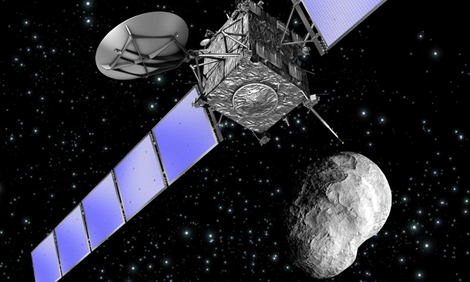


This illustration shows an artist’s idea of what the Rosetta spacecraft looked like as it approached the comet in space.
On August 6, the unmanned spacecraft Rosetta became the first to catch up to a comet in space. A comet is an object made of ice and dust that orbits the sun. Launched in 2004 by the European Space Agency (ESA), Rosetta took 10 years and traveled more than 3 ½ billion miles to reach the comet. It had to loop around the sun five times to get into the right position. It also needed to use the energy of Earth’s and Mars’s gravity to arrive at its final destination.
Rosetta is now in orbit around the comet, which is named 67P/Churyumov-Gerasimenko for the astronomers who discovered it in 1969. The “67P” means that it is the 67th periodic comet discovered. A periodic comet is one that orbits the sun in less than 200 years. The comet is about 2 ½ miles long and 2 miles wide. It has a mass of about 10 billion metric tons. Despite its large mass, the comet would be able to float in the ocean if it could be brought back to Earth. This is because it has a lower density than water due to it being made mostly of ice and dust.
For the next 14 months, Rosetta will travel alongside the comet, studying it with a variety of instruments. Rosetta has already taken many pictures, showing the comet to have a duck-like shape. The photos also reveal that the comet is covered with craters, boulders, and mysterious scrapes.
Later this year, Rosetta will send a probe onto the comet’s surface to get an even closer look. Scientists suspect that the comet could be millions, or even billions, of years old. They hope that the data collected by the probe will provide clues about what the solar system was like long ago. They think the comet will be a “time capsule” of information.
Image credit: ESA
Related Link
- Ambition the film
Watch a short science fiction movie produced by the European Space Agency to promote the Rosetta mission. - ESA – Space for Kids
Learn more about space science, the European Space Agency, and the Rosetta mission.


























